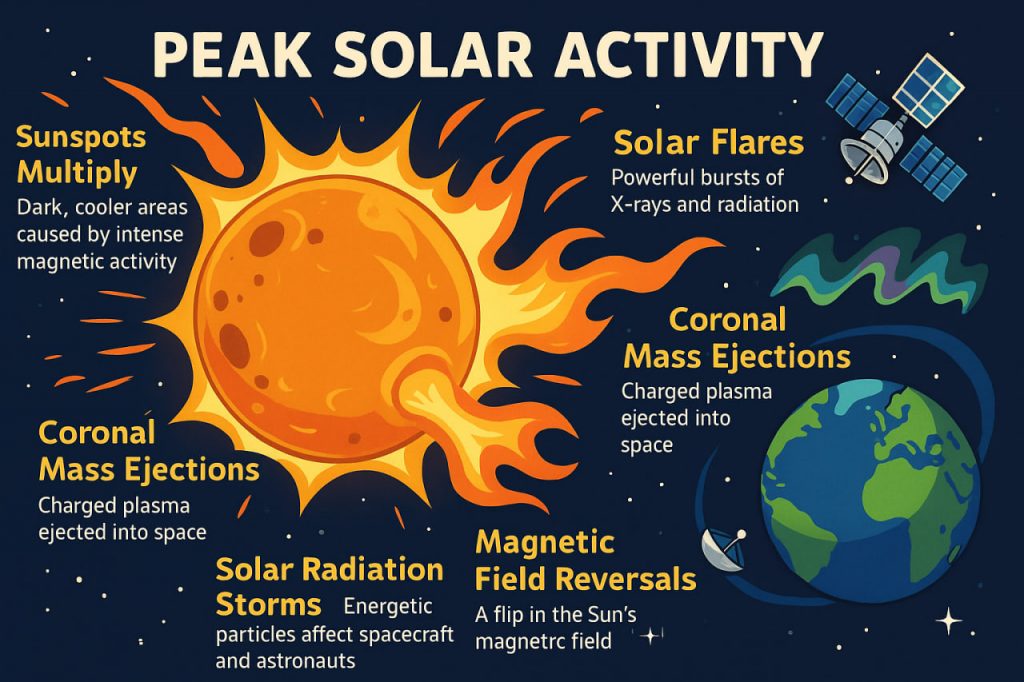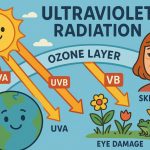The Sun goes through regular cycles of activity known as solar cycles, each lasting about 11 years. The most energetic phase of this cycle is called solar maximum, or peak solar activity, during which the Sun becomes highly dynamic and unstable. Understanding what happens during this period is crucial, as it can have significant effects on both space technology and life on Earth.
The Solar Cycle Explained
The solar cycle is marked by the number of sunspots — dark, cooler regions on the Sun’s surface caused by intense magnetic activity. As the Sun approaches its peak, the number of sunspots increases, signaling a rise in overall solar activity.
The cycle has two key phases:
- Solar Minimum: Fewer sunspots and less magnetic activity.
- Solar Maximum: Increased sunspots, magnetic storms, and energetic eruptions.
We are currently nearing or in Solar Cycle 25, expected to peak around 2025–2026.
Events During Solar Maximum
At peak activity, the Sun undergoes dramatic changes:
- Sunspots Multiply
These magnetic disturbances can trigger solar eruptions and flares. - Solar Flares
Powerful bursts of X-rays and ultraviolet radiation, solar flares can release energy equivalent to millions of nuclear bombs in minutes. - Coronal Mass Ejections (CMEs)
Giant clouds of charged plasma ejected from the Sun’s corona can travel through space at millions of kilometers per hour, potentially reaching Earth. - Auroras Become More Intense
CMEs colliding with Earth’s magnetosphere cause vivid auroras at lower latitudes than usual. - Solar Radiation Storms
High-energy particles emitted during flares and CMEs can affect spacecraft electronics and pose a danger to astronauts. - Magnetic Field Reversals
During solar maximum, the Sun’s entire magnetic field flips, which contributes to its complex behavior.
Effects on Earth and Technology
Solar maximum doesn’t just affect space—it has real-world consequences:
- Satellite malfunctions and GPS disruptions
- Radio blackouts, especially in aviation and military systems
- Power grid failures due to geomagnetic storms
- Increased drag on satellites, causing them to slowly fall toward Earth
- Threats to astronauts aboard space missions from radiation
How We Monitor and Prepare
Organizations like NASA and NOAA use solar observatories (e.g., SOHO, SDO, Parker Solar Probe) to constantly monitor the Sun. This helps:
- Predict solar storms and issue alerts
- Protect satellites and critical infrastructure
- Improve space weather forecasting
Glossary
- Solar flare: A sudden burst of radiation from the Sun’s surface.
- Coronal Mass Ejection (CME): A huge release of plasma and magnetic field from the solar corona.
- Magnetosphere: The magnetic field surrounding Earth, which protects us from solar particles.
- Aurora: Natural light display in the sky caused by charged solar particles interacting with Earth’s atmosphere.
- Solar cycle: The approximately 11-year cycle of solar magnetic activity.


